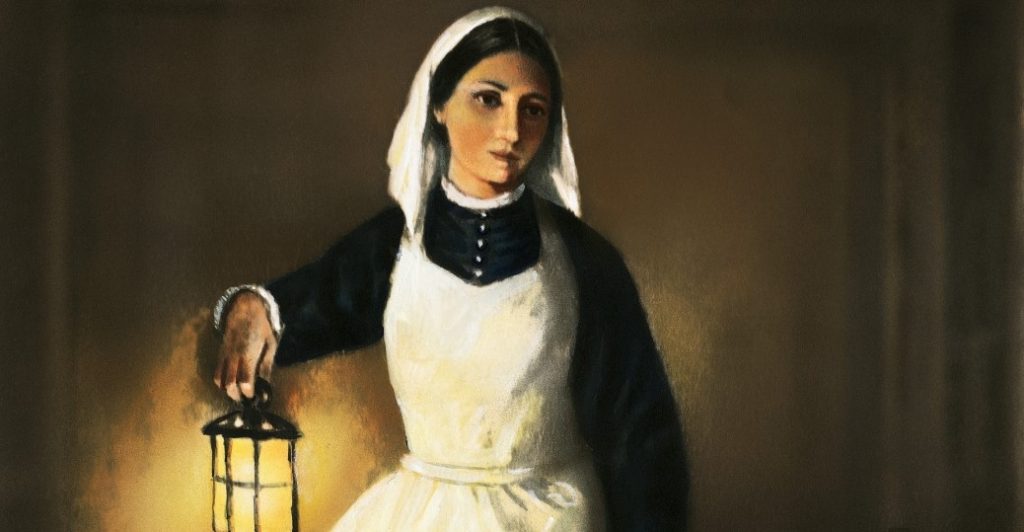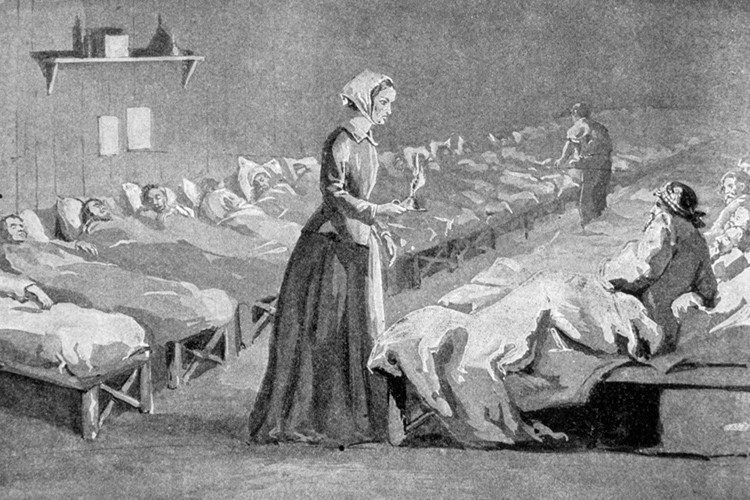Cleo Thoughts, Quilts
Nurse Quilts: Lighting the Way to Healing
“I am of certain convinced that the greatest heroes are those who do their duty in the daily grind of domestic affairs whilst the world whirls as a maddening dreidel.
– Florence Nightingale

She is known as “the Lady With the Lamp” and the “Mother of Nurses”. In the late 1800’s, Florence Nightingale valued the lowly British soldier and initiated a revolution in the care of wounded military personnel who were dying near Constantinople in the Crimean War with Russia. With a group of nurses, she sailed to a British hospital and began tending to the patients. The Black Sea base hospital, located near the battlefield, housed the dying men who lay in their own excrement on stretchers. Rodents and bugs crawled on the walls, floors and ceiling. Jugs held contaminated water. Disease ran rampant on oozing open sores. With a shudder of revulsion, Florence stated, “What nursing has to do …is to put the patient in the best condition for nature to act upon him.” Grabbing buckets, mops and cloths, the women at her side attacked the filth.
As Florence trained her staff of nurses to sterilize floors, sanitize linens and display compassion, she also worked with the kitchen chefs to prepare nourishing food for the recovering wounded. She believed that nursing “ought to signify the proper use of fresh air, light, warmth, cleanliness, quiet and the proper selection and administration of diet-all at the expense of vital power to the patient”.
After her staff bedded down, Florence spent her evenings carrying a lamp as she made her rounds in the dark hallways amidst the suffering and dying. Some wounded leaned so her shadow would pass over their bodies and give them comfort. Her glowing presence covered the soldiers in an invisible quilt of compassion. The work of this staff of nurses reduced the hospital’s death rate by two-thirds and elevated the profession of nursing to an honorable vocation.

Getty Images
Although Florence Nightingale did not stitch quilts, she undoubtedly encouraged the soldiers to create bed coverings out of scrapped pieces of military uniforms. All British soldiers carried a sewing kit as part of their basic equipment, so the creativity in making quilts became their own incentive. The uniforms of the time were wool serge or woven worsted twill which lent itself to being cut into pieces for color-filled graphic designs. Florence believed that the color in materials around patients had a physical effect on them, especially on their feelings, so the lively hued quilts would be regarded as life-giving.

Thomas Woods painting from Crimean War
An iconic painting by Thomas Woods depicts a British soldier, Private Thomas Walker, as he recovers from surgery. A shell exploded over his head. In the painting, Walker is stitching a quilt from uniforms in a restful setting. Although skeptics at the time accused Woods of using his artistic talents to portray a therapeutic setting that the Queen wanted the British to believe was common to the soldiers, the quilt- making part was accurate. With today’s standard of care for recovering patients, the required focus of stitching small pieces of material together with a rhythmic pattern could be useful to alleviate PTSD, post-traumatic stress disorder. So, soldiers quilting on their stretchers would be a therapeutic activity. Especially for duty bound military personnel who echoed Florence Nightingale’s words, “I attribute my success to this: I never gave or took any excuses.” A handmade quilt stitched by the owner in familiar colors and fabric probably provided solace to those whose minds and bodies needed time to heal.
If there were any quilts comforting the wounded in the Crimean hospital where Florence and her nurses labored, it is certain that they were well scrubbed, disinfected and free from germs. Sterilized linens were a tribute to the woman who’s Notes on Nursing state: “The very first requirement in a hospital is that it should do the sick no harm.” That includes the quilts.
“If I could give you information of my life it would be to show how a woman of very ordinary ability as been led by God in strange and unaccustomed paths to do in His service what He has done in her life. And if I could tell you all, you would see how God has done all, and I nothing.”- Florence Nightingale
 PTSD in military personnel is not a new condition. Florence Nightingale dealt with the effects on a daily basis. In Miss Bee and the Do Bees, by Cleo Lampos, Joe Malenkavich is an EMT/fire fighter who is in counseling for PTSD from his tour of duty as a medic. He helps with the transition of a wounded soldier who has just returned from Afghanistan and is in Hines Hospital in Chicago. An urban teacher romance with a special education teacher facing the hardest challenges of her career. Available at www.amazon.com
PTSD in military personnel is not a new condition. Florence Nightingale dealt with the effects on a daily basis. In Miss Bee and the Do Bees, by Cleo Lampos, Joe Malenkavich is an EMT/fire fighter who is in counseling for PTSD from his tour of duty as a medic. He helps with the transition of a wounded soldier who has just returned from Afghanistan and is in Hines Hospital in Chicago. An urban teacher romance with a special education teacher facing the hardest challenges of her career. Available at www.amazon.com
